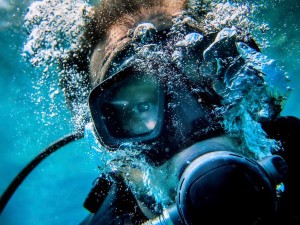Runaway Inflation — Can You Handle It?
Intending to give your BC a tiny blip of air, you touch the power inflator button. But the button sticks, your BC begins inflating rapidly and suddenly you are heading for the surface. What now?
BREATHE
You are now making an uncontrolled ascent. Relax, breathe easy to keep your airway open so your lungs can vent, and look up for overhead obstacles like the bottom of the boar. At the same time:
DUMP AIR
Calmly, but immediately, dump air from your BC by whatever means works best. On most BCs, that means yanking on the corrugated inflation hose on your left shoulder to open the remote exhaust valve. Some BCs have a toggle on the right side that opens the valve. A few BCs actually dump air faster through the oral inflator.
GET NEUTRAL
Regain neutral buoyancy by modulating the dump valve. Either your remote exhaust, your oral deflate or both will dump air faster than the power inflator can put in. So even if the power inflator is stuck fully open (an unlikely worst case), either valve should allow you to get ahead of it and re-establish buoyancy control. Calm down and take a moment to relax.
JIGGLE THE BUTTON
Is the power inflator still leaking? Sand may be lodged on the valve seat. Try pushing the button again, wiggling it and flushing water through it; the button may come unstuck. Or it may not have been stuck in the first place. Most uncontrolled ascents are actually caused by inattention to depth and buoyancy, not equipment problems. While you’re doing this, keep a sharp eye on your depth so you don’t lose buoyancy control again.
DISCONNECT THE HOSE
If the power inflator is still leaking air into your BC, try to pop off the quick-disconnect. Some will come off easily underwater, some are impossible. lf you can disconnect the air hose, you can still inflate your BC orally and, if you feel comfortable doing so, resume your dive.
FLARE
If you’re too close to the surface and ascending too quickly, you may be unable to regain control of your buoyancy. You can slow your ascent by flaring your body during the last 30 feet. That means arching your back with legs and arms outstretched, like an upside-down sky diver. Flaring can cut your ascent rate in half.
REPORT
Once back on the dive boat, report what has happened to your buddy and the dive leader so they can help you watch for signs of DCI. Be aware of any numbness, tingling, visual perception problems, pain in joints, unusual fatigue, difficulty writing, etc. If symptoms appear or you were near your no-decompression limit when you ascended, consider oxygen therapy.
Source: Sport Diver








